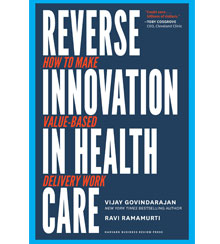Physician, Disrupt Thyself
Professors Vijay Govindarajan and Ravi Ramamurti offer U.S. healthcare providers a prescription for reverse innovation from India.
Reverse Innovation in Health Care: How to Make Value-Based Delivery Work
by Vijay Govindarajan and Ravi Ramamurti, Harvard Business Review Press, 2018
If I were a senior executive in healthcare, it would scare the hell out of me to learn that Amazon founder Jeff Bezos, Warren Buffett of Berkshire Hathaway fame, and JPMorgan Chase CEO Jamie Dimon formed an independent company “free from profit-making incentives and constraints” to provide “simplified, high-quality and transparent healthcare at a reasonable cost” to a million or so of their U.S. employees. The fact that the CEOs chose surgeon and author Atul Gawande — an outspoken critic of the healthcare industry’s practices — to lead it wouldn’t settle my nerves. The news might even be jarring enough to induce me to read Vijay Govindarajan and Ravi Ramamurti’s Reverse Innovation in Health Care. Although that might prove cold comfort indeed.
“The real reason the health-care debate hasn’t gotten anywhere is that would-be reformers are debating about the wrong things,” declare Govindarajan, Coxe Distinguished Professor of Management at Dartmouth College’s Tuck School of Business, and Ramamurti, University Distinguished Professor of International Business and Strategy at Northeastern University. “It’s not about who pays for what. Skyrocketing health insurance premiums are just a symptom of the underlying problem. The problem with American health care is that it costs too much, the quality is uneven, and too many people can’t get the care they need.”
The professors thus blame providers for the fact that the U.S. healthcare system is by far the most expensive in the world while its supposed beneficiaries rank 37th globally in average life expectancy. Healthcare delivery is the problem, they argue.
As we quibble about everything healthcare-related in the U.S., I could quibble with Govindarajan and Ramamurti about whether providers or payors or patients or the fee-for-service, free-market healthcare system itself is to blame for this mess. Clearly, the costs of the U.S. healthcare system have been rising far above the rate of inflation. And given the fact that my very healthy family’s health insurance is its biggest annual outlay, I, for one, would welcome relief from any quarter. Reverse Innovation in Health Care argues that the quarter that the relief is going to come from is…India, which ranks 104th in life expectancy. On the surface, this seems so outlandish that the authors had to include an appendix of questions and answers titled “India? Really?” After they spend an entire book making their case, they had to make it again!
There is a strong contrarian logic at work here. Govindarajan began exploring, with his colleague Chris Trimble, this logic in their book Reverse Innovation, which was named one of the year’s Best Business Books in 2012 by s+b. Reverse innovation is the transfer of new ideas from poor regions to rich regions. These ideas are stimulated by the resource constraints in poor regions. In the case of India, the most dramatic of these constraints is money: In 2014, report the authors, per capita healthcare spending in India was US$75; in the U.S., it was $9,403.
To create viable healthcare business in a market where consumers can’t afford to pay very much, you must get creative. And that’s exactly what the seven “Indian exemplars” that Govindarajan and Ramamurti feature in their book did. “We wrote this book,” they explain, “because we believe the Indian exemplars are the Fords and Toyotas of health care.”
To create viable healthcare business in a market where consumers can’t afford to pay very much, you must get creative.
Take, for instance, Narayana Health, a for-profit provider of cardiac and other tertiary care, which was founded by Dr. Devi Shetty in 2001 and now treats more than 2 million patients per year. “Narayana hospitals charge little more than $2,100 for open-heart surgery that would cost between $100,000 and $150,000 in the United States,” report the authors. “The cost of the surgery is even lower: approximately $1,100 to $1,200 per surgery.” Low cost does not mean low quality: “The hospitals report outcomes on metrics — such as the hospital-acquired infection rate (2.8 per 1,000 ICU days) — that rival those of the best hospitals in the world.”
The authors’ examination of the seven Indian exemplars reveals five core principles of value-based healthcare. These are:
• A driving purpose: Each exemplar is committed to providing healthcare for all comers, regardless of their ability to pay.
• A hub-and-spoke configuration: Each locates its scarcest expertise and equipment in a hub and uses spokes, connected by telecommunications, as gateways and service points for the delivery of less complicated care.
• An enthusiastic use of technology: Costs are reduced using telehealth networks, remote diagnosis and treatment, and electronic medical records.
• Task-shifting and continuous process improvement: Costs are further reduced by shifting rote and low-value tasks away from expensive talent and involving everyone in ongoing improvement efforts.
• A culture of ultra-cost-consciousness: Frugality is a virtue; waste and unnecessary tests and procedures are avoided.
If you’ve read any of the prescriptions for healthcare reform in the U.S. that have been published in the years before the passage of the Patient Protection and Affordable Care Act in 2010 and ever since, none of this will surprise you. We know what needs to be done to fix healthcare, and Reverse Innovation in Health Care confirms it. The problem is that far too few providers are making far too little progress in their own treatment regimens to transform the U.S. healthcare system, which at this point is eating up nearly 18 percent of the nation’s GDP.
If the fact that companies such as Amazon, Berkshire Hathaway, and JPMorgan Chase are getting into the market isn’t enough to motivate U.S. providers, perhaps the thought of Indian exemplars competing with them will do the trick. In 2014, Narayana opened its first overseas venture: a 104-bed specialty hospital on Grand Cayman Island for medical tourists. It’s likely that the others aren’t far behind.
Author profile:
- Theodore Kinni is a contributing editor at strategy+business. He also blogs at Reading, Writing re: Management.



